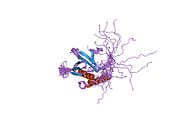| STAP1 |
|---|
|
| Available structures |
|---|
| PDB | Ortholog search: PDBe RCSB |
|---|
| List of PDB id codes |
|---|
1X1F, 3MAZ |
|
|
| Identifiers |
|---|
| Aliases | STAP1, BRDG1, STAP-1, signal transducing adaptor family member 1 |
|---|
| External IDs | OMIM: 604298; MGI: 1926193; HomoloGene: 8103; GeneCards: STAP1; OMA:STAP1 - orthologs |
|---|
| Gene location (Human) |
|---|
 | | Chr. | Chromosome 4 (human)[1] |
|---|
| | Band | 4q13.2 | Start | 67,558,727 bp[1] |
|---|
| End | 67,607,337 bp[1] |
|---|
|
| Gene location (Mouse) |
|---|
 | | Chr. | Chromosome 5 (mouse)[2] |
|---|
| | Band | 5|5 E1 | Start | 86,219,605 bp[2] |
|---|
| End | 86,253,984 bp[2] |
|---|
|
| RNA expression pattern |
|---|
| Bgee | | Human | Mouse (ortholog) |
|---|
| Top expressed in | - lymph node
- epithelium of nasopharynx
- spleen
- appendix
- granulocyte
- bone marrow cells
- testicle
- tonsil
- superficial temporal artery
- blood
|
| | Top expressed in | - granulocyte
- thymus
- spleen
- mesenteric lymph nodes
- olfactory epithelium
- blood
- lumbar spinal ganglion
- subcutaneous adipose tissue
- tibiofemoral joint
- lumbar subsegment of spinal cord
|
| | More reference expression data |
|
|---|
| BioGPS |  | | More reference expression data |
|
|---|
|
| Gene ontology |
|---|
| Molecular function | - macrophage colony-stimulating factor receptor binding
- transmembrane receptor protein tyrosine kinase adaptor activity
- phosphotyrosine residue binding
- receptor tyrosine kinase binding
- protein binding
- phospholipid binding
- protein kinase binding
- signaling adaptor activity
| | Cellular component | - cytoplasm
- mitochondrion
- nucleus
- nucleoplasm
- intracellular membrane-bounded organelle
- protein-containing complex
| | Biological process | - positive regulation of B cell receptor signaling pathway
- positive regulation of phagocytosis, engulfment
- transmembrane receptor protein tyrosine kinase signaling pathway
- negative regulation of ruffle assembly
- positive regulation of microglial cell mediated cytotoxicity
- positive regulation of non-membrane spanning protein tyrosine kinase activity
- negative regulation of microglial cell migration
- positive regulation of gene expression
- positive regulation of microglial cell activation
- negative regulation of phosphorylation
- cellular response to lipopolysaccharide
- negative regulation of macrophage colony-stimulating factor signaling pathway
- positive regulation of actin cytoskeleton reorganization
- negative regulation of macrophage chemotaxis
- response to bacterium
| | Sources:Amigo / QuickGO |
|
| Orthologs |
|---|
| Species | Human | Mouse |
|---|
| Entrez | | |
|---|
| Ensembl | | |
|---|
| UniProt | | |
|---|
| RefSeq (mRNA) | | |
|---|
| RefSeq (protein) | | |
|---|
| Location (UCSC) | Chr 4: 67.56 – 67.61 Mb | Chr 5: 86.22 – 86.25 Mb |
|---|
| PubMed search | [3] | [4] |
|---|
|
| Wikidata |
| View/Edit Human | View/Edit Mouse |
|
 1x1f: Solution structure of the PH domain of human Docking protein BRDG1
1x1f: Solution structure of the PH domain of human Docking protein BRDG1


















